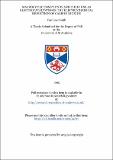Files in this item
Macrocyclic complexes and their use as electrocatalysts for the electrochemical reducation of carbon dioxide
Item metadata
| dc.contributor.advisor | Crayston, Joe A. | |
| dc.contributor.advisor | Hay, Robert W. | |
| dc.contributor.author | Smith, Caroline | |
| dc.coverage.spatial | 214 p. | en_US |
| dc.date.accessioned | 2018-07-02T15:45:23Z | |
| dc.date.available | 2018-07-02T15:45:23Z | |
| dc.date.issued | 1995 | |
| dc.identifier.uri | https://hdl.handle.net/10023/14817 | |
| dc.description.abstract | The environmental problem of carbon dioxide pollution has caused considerable interest over recent years. Much work has concentrated on catalysts for the reduction of carbon dioxide. There are two main methods for the reduction, electrochemical and photochemical reduction. There are several catalysts reported in the literature but the most selective and efficient one for the electrochemical reduction of carbon dioxide to carbon monoxide is nickel(II) 1,4,8,11-tetraazacyclodecane perchlorate (more commonly known as [Ni(cyclam)]²⁺(ClO₄)₂). In order to understand how this catalysis occurs the complex was investigated using a variety of electrodes and solvents in order to determine the best system for catalysis to occur. The best system is an aqueous solution of the complex with sodium perchlorate as the supporting electrolyte and with a mercury working electrode. The effect of macrocycle ring size was investigated using [n]aneN₄ complexes, n = 13 - 16. The highest current produced under carbon dioxide was for the n = 14 ring. Subsequent complexes investigated have a [14]-membered backbone. The other important effect in the macrocyclic structure is the nature of the conformation of the complex. Cyclam itself exists as five conformations, three of which are readily accessible. The other conformations do not reduce carbon dioxide to the same extent as the original [Ni(cyclam)]²⁺. The origin of this difference was shown to be related to the extent of adsorption of each conformer. Also, if the chelate sequence of the cyclam is changed from cyclam to isocyclam the catalytic efficiency is lowered but the potential at which the reduction occurs is more positive. Rotating disc electrochemistry was attempted in order to find a method for comparing the catalytic efficiency of different complexes. A mercury plated copper electrode was used but unfortunately the mercury deteriorated and left behind bare copper. Copper itself showed current plateaux for reduction under carbon dioxide; these current plateaux varied linearly with (rotation rate)1/2. On closer examination the current plateaux were due to the Ni(II/I) reduction and not carbon dioxide reduction. The adsorption of the catalyst onto the mercury is important as it is this adsorbed species that is catalytically active. To determine the nature of the catalytic species various electrochemical techniques such as chronocoulometry and a.c. impedance were employed to measure the extent of the adsorption. Chronocoulometry showed that adsorption occurred on the mercury, but adsorption onto the copper surface was inhibited in the presence of carbon dioxide. A.C. impedance spectroscopy showed that adsorption occurred at -1.20 V which is considerably more positive than the redox potential of the complex. A variety of unsaturated macrocycles were also investigated for catalytic behaviour. As the unsaturated macrocycles have lower redox potentials than the corresponding saturated macrocycle, the result should be that the potential for the reduction becomes more positive. However with these macrocycles no reduction of carbon dioxide is observed under the same conditions as [Ni(cyclam)]²⁺, A series of new catalysts has been identified. These complexes have the ability to reduce carbon dioxide at more positive potentials with a greater current efficiency, than [Ni(cyclam)] ²⁺. The new catalysts are based on a [14aneN6 backbone. The extra nitrogen atoms appear to stabilise the intermediate hydrogen bonded NiI-CO₂ adduct. | en_US |
| dc.language.iso | en | en_US |
| dc.publisher | University of St Andrews | |
| dc.subject.lcc | QD281.R4S6 | |
| dc.subject.lcsh | Reduction (Chemistry) | en |
| dc.title | Macrocyclic complexes and their use as electrocatalysts for the electrochemical reducation of carbon dioxide | en_US |
| dc.type | Thesis | en_US |
| dc.contributor.sponsor | Engineering and Physical Sciences Research Council (EPSRC) | en_US |
| dc.type.qualificationlevel | Doctoral | en_US |
| dc.type.qualificationname | PhD Doctor of Philosophy | en_US |
| dc.publisher.institution | The University of St Andrews | en_US |
This item appears in the following Collection(s)
Items in the St Andrews Research Repository are protected by copyright, with all rights reserved, unless otherwise indicated.

